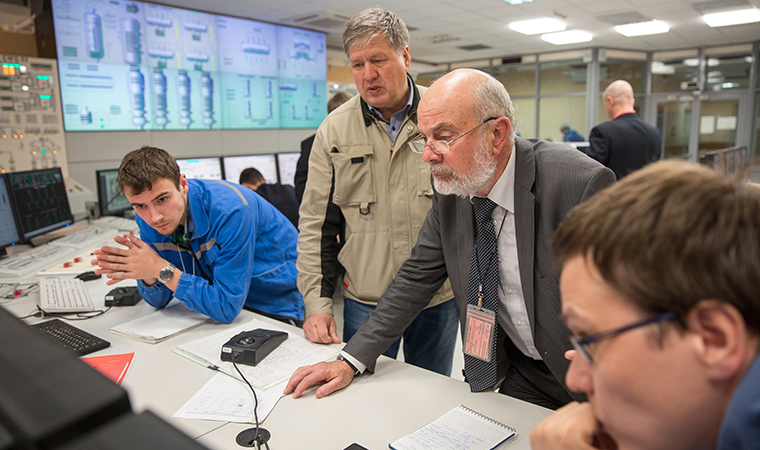
Latest news from nuclear construction sites
back to contentsNovovoronezh NPP
Achieving the criticality and physical tests at the critical level are the two final steps of the reactor start-up process. At this stage, the chain reaction is self-sustained to produce a neutron flux, while the reactor operates at a less than 1% capacity.
“This news is of global importance because it is about the world’s first Generation III+ unit,” Rosatom CEO Sergei Kirienko commented on the event.
“The next step is to bring the unit online. It will begin with generator rotors reaching the rated idle rotation speed. The new unit will be connected to the grid in the summer of 2016 and put in commercial operation by the end of the year.
Unit 6 of Novovoronezh NPP has a standard Generation III+ design boasting greater efficiency and enhanced safety systems. It is based on the AES-2006 concept with a VVER-1200 nuclear reactor. What makes this innovative design especially interesting is that it features passive safety systems supplementing conventional active systems.
Rostov NPP
Rostov NPP Unit 4 has entered another critical project phase as the welding began on the main circulation circuit. The task is planned to be completed within an unprecedentedly short period of 105 days.
“We follow the example of our colleagues from Leningrad NPP-2. They welded the main circulation circuit in 113 days, and we will try to do this job in 105 days,” said Valery Limarenko, CEO of ASE Group (a general contractor of the project), when outlining the time schedule for this major piece of installation work. “The time reduction will be achieved with no trade-off in quality, but rather through the optimization and strict scheduling of work processes.”
Quality of each welding step will be controlled with a number of tests, including visual, dimensional, x-ray, penetrant and ultrasonic examinations. Meanwhile, the work is ongoing in the reactor island. All the heat exchanging equipment has been mounted, with the assembly of the turbine now underway.
The construction site of Unit 4 is being prepared for the installation of a pressurizer, the last large-size component of the reactor. The pressurizer is undergoing incoming inspection prior to be delivered to the installation area. It is designed to maintain the required pressure in the primary circuit during the start-up or temperature fluctuations. The pressurizer is a high pressure vessel with built-in electric heating units. When in operation, it is filled with water and steam.
A crucial test operation, detection of leaks in the open circuit, is scheduled for December 2016.
At the moment, there are more than 4,000 people engaged on the construction site. However, contractors are recommended to increase staff numbers to meet the deadline. The startup of Rostov NPP Unit 4 is scheduled for 2017.
Leningrad NPP
In May, the foundation for Unit 1 turbine was concreted at Leningrad NPP. “The turbine foundation is a complex structure designed to uniformly spread considerable loads caused by a high-speed turbine. It was constructed in several steps, with concrete quality examined to comply with stringent requirements at every step,” said Anatoly Maksimov, Senior Engineer at the Leningrad NPP Technical Supervision Department. “Sustainable and seamless operation of both the turbine and the whole power unit depends on how firmly and securely the foundation is laid.”
As concrete reaches its designed strength, the inspection commission will check the foundations for quality. After that, the construction phase in the turbine island of Unit 1 will be deemed completed. When the concreting is done, the engineers will be able to begin full-scale installation of the generator components in the turbine island of Unit 1. Embedded items have already been installed and concreted under the railway to carry the generator rotor inside the building.
Currently, Leningrad NPP is preparing for the incoming inspection of dummy assemblies for Unit 1. The dummies will be used during the hot and cold runs to check the reactor for compliance with the designed thermal and hydraulic parameters.
“There are a number of necessary requirements to be complied with during the incoming inspection and loading of dummy assemblies. First of all, we have to commission a fresh fuel storage facility. For this purpose, all the construction part should be completed, and we have to put in operation a crane with a capacity of 40/5 tons,” said Andrei Kolychev, Deputy Head of the Nuclear Safety Department at Leningrad NPP.
Andrei Kuznetsov, Deputy Manager of the Leningrad NPP Centralized Repairs Department, said: “We have mounted an electric traveling crane with a 40/5-ton capacity in the storage building. Its electric components have been connected ant tested. We are now preparing for static and dynamic tests on the crane to prove robustness of its steel structures and reliability of its mechanisms. After the quality of installations and key working parameters are verified, it will be inspected and registered by the Russian regulator Rostechnadzor. The plans are to put the crane in operation by the end of the second quarter of 2016.”
The pressurizing system of the now constructed Unit 2 is being installed in the reactor building. The suppression pool, an important piece of the nuclear station equipment, has been placed in its permanent position. It serves to condense the steam coming from the pressurizer. When the suppression pool is installed, construction will be resumed in the reactor building of Unit 2. This includes reinforcement and concreting of a ceiling slab at the designed level, as well as erection of internal structures up to Level +25.10.




